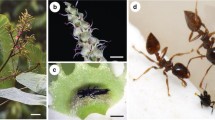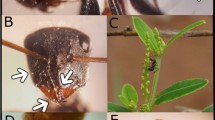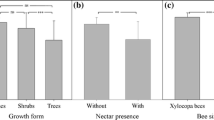Abstract
The antibiotic hypothesis proposes that ant pollination is rare at least in part because the cuticular antimicrobial secretions of ants are toxic to pollen grains. We tested this hypothesis by comparing the effects of ants and bees on pollen in two regions: a tropical rainforest in Amazonian Peru and temperate forests and old fields in Canada. We found support for three predictions that follow from the antibiotic hypothesis. (1) For all 10 ant and 11 plant species in our study, contact with ants significantly reduced pollen germination, confirming the generality of this effect. (2) Contact with two bee species did not have similar effects; pollen exposed to bees germinated as well as control pollen. (3) Consistent with the presumed greater abundance of entomopathogens in the tropics, which may have selected for stronger antibiotic secretions in tropical ants, tropical ants had more negative effects on pollen than temperate ants. We speculate that the antibiotic hypothesis contributes not only to the rarity but also to the biogeography of ant pollination, and we discuss whether the negative effects of ants on pollen have resulted in selection for floral defenses against ants.

Similar content being viewed by others
References
Adler L (2000) The ecological significance of toxic nectar. Oikos 91:409–420
Beattie AJ, Turnbull C, Knox RB, Williams EG (1984) Ant inhibition of pollen function: a possible reason why ant pollination is rare. Am J Bot 71:421–426
Beattie AJ, Turnbull CT, Hough T, Jobson S, Knox RB (1985) The vulnerability of pollen and fungal spores to ant secretions: evidence and some evolutionary implications. Am J Bot 72:606–614
Bhatkar A, Whitcomb WH (1970) Artificial diet for rearing various species of ants. Fla Entomol 53:229–232
Bot ANM, Ortius-Lechner D, Finster K, Maile R, Boomsma JJ (2002) Variable sensitivity of fungi and bacteria to compounds produced by the metapleural glands of leaf-cutting ants. Insectes Soc 49:363–370
Brewbaker JL, Kwack BH (1963) The essential role of calcium ion in pollen germination and pollen tube growth. Am J Bot 50:859–865
de Vega C, Arista M, Ortiz PL, Herrera CM, Talavera S (2009) The ant-pollination system of Cytinus hypocistis (Cytinaceae), a Mediterranean root holoparasite. Ann Bot 103:1065–1075
Feinsinger P, Swarm LA (1978) How common are ant-repellent nectars? Biotropica 10:238–239
Fernández-Marín H, Zimmerman JK, Rehner SA, Wcislo WT (2006) Active use of the metapleural glands by ants in controlling fungal infection. Proc R Soc B 273:1689–1695
Galen C, Butchart B (2003) Ants in your plants: effects of nectar-thieves on pollen fertility and seed-siring capacity in the alpine wildflower, Polemonium viscosum. Oikos 101:521–528
Garcia MB, Antor RJ, Espadaler X (1995) Ant pollination of the palaeoendemic dioecious Borderea pyrenaica (Dioscoreaceae). Plant Syst Evol 198:17–27
Ghazoul J (2001) Can floral repellents pre-empt potential ant-plant conflicts? Ecol Lett 4:295–299
Gomez JM, Zamora R (1992) Pollination by ants: consequences of the quantitative effects on a mutualistic system. Oecologia 91:410–418
Graystock P, Hughes WOH (2011) Disease resistance in a weaver ant, Polyrhachis dives, and the role of antibiotic-producing glands. Behav Ecol Sociobiol 65:2319–2327
Guernier V, Hochberg ME, Guégan J-F (2004) Ecology drives the worldwide distribution of human diseases. PLoS Biol 2:0740–0746
Guerrant EO, Fiedler PL (1981) Flower defenses against nectar-pilferage by ants. Biotropica 13:25–33
Haber WA, Frankie GW, Baker HG, Baker I, Koptur S (1981) Ants like floral nectar. Biotropica 13:211–214
Harris FLC, Beattie AJ (1991) Viability of pollen carried by Apis mellifera L., Trigona carbonaria Smith and Vespula germanica (F.) (Hymenoptera: Apidae, Vespidae). J Aust Entomol Soc 30:45–47
Herrera CM (1987) Components of pollinator ‘quality’: comparative analysis of a diverse insect assemblage. Oikos 50:79–90
Hickman JC (1974) Pollination by ants: a low-energy system. Science 184:1290–1292
Hoffman AA, Clancy DJ, Merton E (1994) Cytoplasmic incompatibility in Australian populations of Drosophila melanogaster. Genetics 136:993–999
Hoggard SJ, Wilson PD, Beattie AJ, Stow AJ (2011) Social complexity and nesting habits are factors in the evolution of antimicrobial defences in wasps. PLoS ONE 6:e21763
Hölldobler B, Engel-Siegel H (1984) On the metapleural gland of ants. Psyche 91:201–224
Hölldobler B, Wilson EO (1990) The ants. The Belknap Press of Harvard University Press, Cambridge
Hull DA, Beattie AJ (1988) Adverse effects on pollen exposed to Atta texana and other North American ants: implications for ant pollination. Oecologia 75:153–155
Janzen DH (1977) Why don’t ants visit flowers? Biotropica 9:252
Junker RR, Blüthgen N (2008) Floral scents repel potentially nectar-thieving ants. Evol Ecol Res 10:295–308
Junker RR, Daehler CC, Dötterl S, Keller A, Blüthgen N (2011) Hawaiian ant-flower networks: nectar-thieving ants prefer undefended native over introduced plants with floral defenses. Ecol Monogr 81:295–311
Lach L (2005) Interference and exploitation competition of three nectar-thieving ant species. Insectes Soc 52:257–262
Ness JH, Morin DF, Giladi I (2009) Uncommon specialization in a mutualism between a temperate herbaceous plant guild and an ant: are Aphaenogaster ants keystone mutualists? Oikos 118:1793–1804
Nicklen EF, Wagner D (2006) Conflict resolution in an ant-plant interaction: Acacia constricta traits reduce ant costs to reproduction. Oecologia 148:81–87
Nunn CL, Altizer SM, Sechrest W, Cunningham AA (2005) Latitudinal gradients of parasite species richness in primates. Divers Distrib 11:249–256
Peakall R, Beattie AJ (1989) Pollination of the orchid Microtis parviflora R. Br. by flightless worker ants. Funct Ecol 3:515–522
Peakall R, Angus CJ, Beattie AJ (1990) The significance of ant and plant traits for ant pollination in Leporella fimbriata. Oecologia 84:457–460
Pitman NCA (2008) An overview of the Los Amigos watershed, Madre de Dios, southeastern Peru. http://cicra.acca.org.pe/espanol/paisaje_biodiversidad/los-amigos-overview9.pdf
Poulsen M, Bot ANM, Nielsen MG, Boomsma JJ (2002) Experimental evidence for the costs and hygienic significance of the antibiotic metapleural gland secretion in leaf-cutting ants. Behav Ecol Sociobiol 52:151–157
Proctor M, Yeo P (1972) The Pollination of Flowers. Taplinger Publishing Company, New York
Puterbaugh M (1998) The role of ants as flower visitors: experimental analysis in three alpine plant species. Oikos 83:36–46
Rader R, Edwards W, Westcott DA, Cunningham SA, Howlett BG (2011) Pollen transport differs among bees and flies in a human-modified landscape. Divers Distrib 17:519–529
Raine NE, Willmer P, Stone GN (2002) Spatial structuring and floral avoidance behavior prevent ant-pollinator conflict in a Mexican ant-acacia. Ecology 83:3086–3098
Ramsey M (1995) Ant pollination of the perennial herb Blandfordia grandiflora (Liliaceae). Oikos 74:265–272
Richards JS, Stanley JN, Gregg PC (2005) Viability of cotton and canola pollen on the proboscis of Helicoverpa armigera: implications for spread of transgenes and pollination ecology. Ecol Entomol 30:327–333
Rico-Gray V, Oliveira PS (2007) The ecology and evolution of ant-plant interactions. The University of Chicago Press, Chicago
Schemske DW, Mittelbach GG, Cornell HV, Sobel JM, Roy K (2009) Is there a latitudinal gradient in the importance of biotic interactions? Annu Rev Ecol Evol Syst 40:245–269
Stow AJ, Beattie A (2008) Chemical and genetic defenses against disease in insect societies. Brain Behav Immun 22:1009–1013
Stow A, Briscoe D, Gillings M, Holley M, Smith S, Leys R, Silberbauer T, Turnbull C, Beattie A (2007) Antimicrobial defences increase with sociality in bees. Biol Lett 3:422–424
Stow A, Turnbull C, Gillings M, Smith S, Holley M, Silberbauer L, Wilson PD, Briscoe D, Beattie A (2010) Differential antimicrobial activity in response to the entomopathogenic fungus Cordyceps in six Australian bee species. Aust J Entomol 49:145–149
Thomson J (2003) When is it mutualism? Am Nat 162:S1–S9
Thorp RW (2000) The collection of pollen by bees. Plant Syst Evol 222:211–223
Turillazzi S, Mastrobuoni G, Dani FR, Moneti G, Pieraccini G, la Marca G (2006) Dominulin A and B: two new antibacterial peptides identified on the cuticle and in the venom of the social paper wasp Polistes dominulus using MALDI-TOF, MALDI-TOF/TOF, and ESI-Ion trap. J Am Soc Mass Spectrom 17:376–383
Veal DA, Trimble JE, Beattie AJ (1992) Antimicrobial properties of secretions from the metapleural glands of Myrmecia gulosa (the Australian bull ant). J Appl Bacteriol 72:188–194
Wagner D (2000) Pollen viability reduction as a potential cost of ant association for Acacia constricta (Fabaceae). Am J Bot 87:711–715
Walker TN, Hughes WOH (2011) Arboreality and the evolution of disease resistance in ants. Ecol Entomol 36:588–595
Weir TL, Newbold S, Vivanco JM, van Haren M, Fritchman C, Dossey AT, Bartram S, Boland W, Cosio EG, Kofer W (2011) Plant-inhabiting ant uses chemical cues for host discrimination. Biotropica. doi:10.1111/j.1744-7429.2011.00786.x
Willmer PG, Stone GN (1997) How aggressive ant-guards assist seed-set in Acacia flowers. Nature 388:165–167
Willmer PG, Nuttman CV, Raine NE, Stone GN, Pattrick JG, Henson K, Stillman P, McIlroy L, Potts SG, Knudsen JT (2009) Floral volatiles controlling ant behaviour. Funct Ecol 23:888–900
Wilson P, Thomson JD (1991) Heterogeneity among floral visitors leads to discordance between removal and deposition of pollen. Ecology 72:1503–1507
Yek SH, Mueller UG (2011) The metapleural gland of ants. Biol Rev 86:774–791
Acknowledgments
We thank Lina Arcila Hernández, Adam Cembrowski, Antonio Coral, Eddie Ho, Gabriel Miller, and Jon Sanders for field/laboratory assistance; Frank Azorsa Salazar, Laurence Packer, and Claus Rasmussen for identifying our Peruvian ants and bee; Takashi Makino, Alison Parker, and James Thomson for their comments and for supplying the B. impatiens; the residents of Port Whitby for allowing us to collect flowers; the directors and staff at CICRA/the Amazon Conservation Association and the Koffler Scientific Reserve at Jokers Hill for logistics and permission to work at these sites; and the Peruvian Ministry of Agriculture for issuing a research permit (No. 299-2011-AG-DGFFS-DGEFFS). We are also grateful to the AE and two anonymous reviewers for their comments on an earlier draft. A Natural Sciences and Engineering Research Council of Canada (NSERC) Discovery Grant to MEF funded this research; EMD was also supported by an NSERC Undergraduate Student Research Award.
Author information
Authors and Affiliations
Corresponding author
Additional information
Handling Editor: Neal Williams.
Rights and permissions
About this article
Cite this article
Dutton, E.M., Frederickson, M.E. Why ant pollination is rare: new evidence and implications of the antibiotic hypothesis. Arthropod-Plant Interactions 6, 561–569 (2012). https://doi.org/10.1007/s11829-012-9201-8
Received:
Accepted:
Published:
Issue Date:
DOI: https://doi.org/10.1007/s11829-012-9201-8




